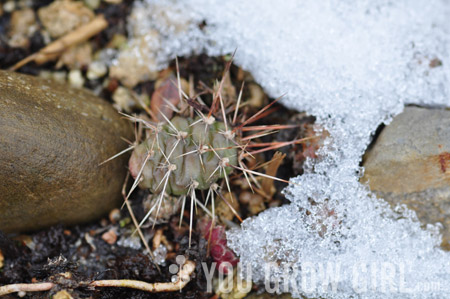
At least a decade has passed since I first discovered and started growing cold hardy opuntia and yet it still comes as a surprise that they exist, like some mythical unicorn come to life. And there are so many of them! Some have thick paddles like the big opuntia that produce edible pears in southern climates. Others have thin leaves and stand tall — a lot taller than you’d think possible in freezing climates.
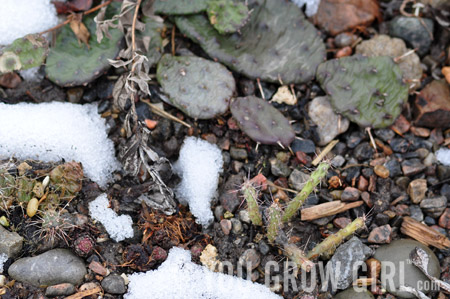
I used to grow winter hardy cactus in pots on the old roof garden, and I had small success (and mostly failure) growing them in the barren earth next to the building; however, moving to a place with a yard was an opportunity to give them a permanent place of importance and experiment with a dry garden bed, albeit on a small scale.
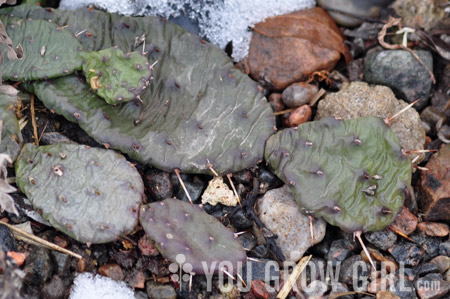
My new opuntia patch sits midway up the yard on high ground, in a spot that receives a lot of direct sun. I’ve been blessed with lightly sandy soil here, so I didn’t have to do anything to prepare it. I added a small amount of organic duck manure to that area when we first dug up the yard last spring, and mulched with pea pebbles last fall. I would have loved to get some big rocks in there to create height and structure, but they do not come cheaply and weren’t in the budget. It’s technically a dry bed in general, and home to a variety of salvias, lavender, alliums, and Agastache, but a small portion has been set aside for opuntia.
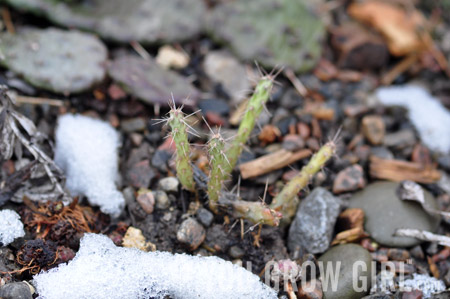
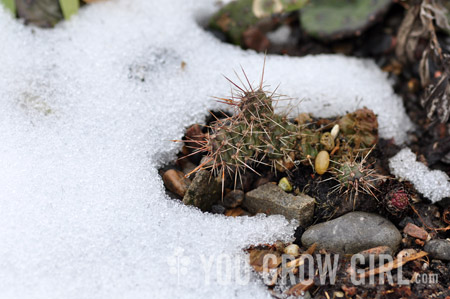
I took these photos last week when we still had snow on the ground, but it was already melting quickly. I can’t tell you the names of any of these varieties, I hardly recall how I acquired some of them. Like many succulents, opuntia reproduce easily from cuttings and that’s how I’ve managed to snag a few of mine. If you’re in the Toronto area. Humber Nurseries has a large selection that tempt me every spring when Melanie and I make our annual visit. Considering the success I’ve had in this new space, I suspect I will not be able to resist so easily this year.
Tip: Opuntia spines hurt, but what’s worse are the glochids, tiny, hair-like spines that get into the skin and cause all manner of irritation. The only protection I have found against them is to wear a pair of leather work gloves when handling opuntia (beware of the glochids that get stuck in the gloves) and forceps for small jobs.
You do see the odd Opuntia outdoors in Cornwall, but I wouldn’t describe them as looking happy. O. humifusa is supposed to be one of the hardiest species, but I reckon the slugs might finish it off in a typical wet winter here.
I can definitely see people in the UK or on the west coast of North America having issues with these. They really do need well draining soil and dryness. Which is why I’ve had some failure with them and up until now had more success keeping them in containers.
These are some really fun plants but glochids and I do not mix! I remember a few streets down, there was a house with one of the large flat segmented varieties. They also has some big agaves but believe they were brought in for the winter.
I hate them too, yet somehow I persevere and keep going back for more.
I discovered opuntia when I was out on a construction site a decade ago. It was pretty widely growing in the area – kind of odd to see cactus in a freeway median in Michigan!
Michigan you say? Fascinating! I will have to look out for that next time I am in Michigan.
i had prickly pear cactus in my back yard in Cocoa Florida growing up we used to pick the fruit and make mud pies out of them lol … and now i find out you can make jelly out of them and that they are really benifical to your health;)
We have wet clay here but it would be great to grow these in containers. I have never thought of growing a cactus in the Ardennes. How inspiring! Will keep this in mind. Thanks Gayla
Wow – I had never heard of these, but now I’m super interested. I’ll have to find some seeds – what a cool find!